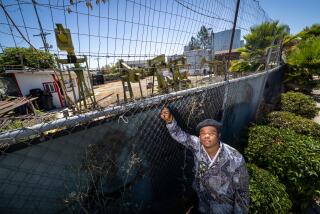A First Step--at Last : Health: Because causes can be traced in only 40% of breast-cancer cases, activists say it’s time to stop blaming the patient and start studying environmental factors. Now, the government is listening.
- Share via
Members of the National Breast Cancer Coalition were determined--and just a little defiant--Monday when they entered the White House to hand over a stack of dogeared and crumpled papers bearing 2.6 million signatures collected from every corner of the nation.
The petitions urged President Clinton to find a cure for breast cancer by creating a “national comprehensive strategy.”
But what these women really mean is that they are tired of being told to do regular breast self-exams and mammograms and to watch their diets.
What they want, they say, is more research on what is causing one in nine American women to develop breast cancer over a lifetime, among the highest rates in the world.
They suspect something in the environment may be responsible for this “epidemic.” And they want researchers to start looking at landfills, toxic dumps and electromagnetic fields--places where breast-cancer researchers have yet to venture.
Clinton received the petitions warmly, acknowledging that there is much to learn about breast cancer and adding: “When it comes to health-care research and delivery, women can no longer be treated as second-class citizens.”
“No one has found out what causes breast cancer,” said Jane Alsobrook, an activist with the Los Angeles Breast Cancer Alliance. She and 200 others participated in a breast-cancer rally held on a recent Sunday afternoon at the Federal Building in Westwood. “People keep looking at the link to hormones and the diet. But it’s the environment that seems suspicious to us.”
Alsobrook says that during the Carter Administration, researchers began to pursue possible environmental causes of disease. But she and other activists charge that health officials in the Reagan and Bush administrations seemed more interested in individual risk factors, such as high-fat diets, she charges.
“The research on the environment was just stopped,” says Alsobrook. “Women were herded back into this little room and (told) ‘You’re eating too much fat. You weigh too much. You’re not getting enough exercise. It’s something you’re doing.’ People keep saying we should take better care of ourselves. But if (the cause) is in the air and food and soil, what can we do about that?”
Activists say they have grown impatient with theories that “blame the victim.” They want to know why women in Contra Costa County have a 40% higher incidence than women in Kern County. They want to know why breast-cancer rates on Long Island are 15% higher than the rest of New York state.
Scientists already know that women with a family history of the disease and those with certain reproductive histories (such as having children late in life) are at increased risk of developing breast cancer. But what troubles many patients is that two-thirds of them have none of the known risk factors, says Dr. Susan Sieber of the National Cancer Institute (NCI).
“We don’t know very much about environmental agents that might be contributing to breast-cancer risk. But the fact remains that we can only account for about 40% of breast-cancer cases, based on well-known and recognized risk factors, like family history,” Sieber says. “So there are a lot of cases that we have very little idea about the cause.”
Because of these unexplained cases, the federal government has launched its first studies on breast cancer and the environment.
*
What is significant about the petition drive, the rally in Westwood and the many other events held around the nation in October--Breast Cancer Awareness Month--is that advocates are successfully pressing science to look at possible environmental causes, an area breast-cancer researchers have largely ignored.
Barbara Balaban, director of a breast-cancer hot line on Long Island, hit the ceiling one day last year when she heard that state officials had dismissed a possible environmental link to explain the abnormally high-breast cancer rate on Long Island.
“The real turning point in my activism was when the state issued those studies . . . and they said that no further studies are indicated at this time. That absolutely blew me away,” says Balaban.
Angry activists took their concerns to the federal government, and Balaban was invited to sit on a Centers for Disease Control and Prevention panel to explore the issue. The federal panel also concluded that the characteristics of the Long Island women--their age, ethnicity and reproductive lives--were most likely responsible for the higher rate.
“They steadfastly refused to look at the environmental issue,” Balaban says. “They said it was too complicated and too expensive to look at. I said, ‘Don’t tell me it’s too difficult. If it’s too difficult, try harder.’ ”
Angered twice, the New York advocates took matters into their own hands. They organized a two-day meeting, set for next month on Long Island, that will bring together medical and environmental researchers to explore this issue, Balaban says.
“Previous research on the environment and breast cancer has been grossly insufficient,” she says. “The goal of this meeting is for us to give the scientists the opportunity to present their best new thinking and to brainstorm on what the best steps might be.”
The meeting has great symbolic value. With the formation of the three-year-old National Breast Cancer Coalition, federal funding for research has increased from $43 million in 1991 to $300 million this year. And these advocates have the ability to shape research, says Dr. Susan Love, a UCLA surgeon and co-founder of the coalition.
“There has been an emphasis on defining risk factors for individual women rather than looking at the bigger picture,” Love says. “I think that’s why the political activism is significant. It’s saying we need to look at society.”
*
Breast-cancer activists and researchers agree on some things:
* No one knows what causes breast cancer.
* There is virtually no proof that anything in the environment causes breast cancer. However, two recent studies have offered the first tantalizing clues that environmental factors--pesticide exposure, in particular--may play a role.
* The cause is probably a blend of factors: environment, lifestyle and heredity.
* Longstanding theories regarding hormone levels and diet are still plausible, although there is now much less certainty about a link to a high-fat diet.
About 175,000 American women get breast cancer each year and 45,000 more die. Of those who get the disease, 30% to 40% can probably be explained by some known risk factors, such as heredity and hormone levels.
Scientists know, for example, that a women who has a mother and sister with breast cancer has about 2 1/2 times the normal risk of developing the disease.
In addition, women who started their periods at a very young age, had a late menopause, had no children or had children at a late age are also at a higher risk.
All these factors are related to a woman’s exposure to levels of the hormone estrogen, says Dr. Ronald Ross, of the USC/Norris Comprehensive Cancer Center. “Breast cancer is a disease of strong hormonal increases. You don’t need to look to any further than the link between age and breast cancer to see how strong these hormonal influences are.”
Ross and others suggest that if any environmental or dietary factors are found to play a role in the development of the disease, it might be through a mechanism that would interfere with hormone levels.
*
Until recently, there was little reason to explore the environment for clues on breast cancer. But two studies have changed that.
One study found that levels of the chemical DDE--which is the form of the pesticide DDT when stored in fat tissue--were higher in tissue taken from women with breast tumors than in breast tissue from women without the disease.
And, in an April article published in the Journal of the National Cancer Institute, Dr. Mary Wolff of the Mount Sinai School of Medicine reported that blood samples taken from women with breast cancer had significantly higher levels of DDE than women who did not have breast cancer.
Although the numbers of women studied in both studies were small, the papers “enhanced our interest in this area,” says the NCI’s Sieber.
An NCI study now under way is examining 600 women and men on farms in Michigan that were heavily contaminated with pesticides in an agricultural accident in the 1970s. In that accident, pesticide was accidentally mixed into feed for farm animals, resulting in widespread contamination of milk, animal meat and people in the area.
Researchers have looked at other effects of the contamination, and now will be looking at breast-cancer rates.
In another study, scientists will look at the breast-cancer incidence of women in Triana, Ala., where residents have long fished from the Tennessee River which was, heavily contaminated with DDT from the 1940s to 1970s.
Environmental activists point to other clues they say deserve attention. In a report released Oct. 14, Greenpeace says exposure to organochlorines--the chemicals that are used to manufacture pesticides--deserves greater scrutiny.
“Organochlorines are first-class poisons. They are bioaccumulative. That means they collect in fat tissue. The breast is a fatty organ,” says Joan D’Argo of Greenpeace. “We have to ask the hard questions. What is causing this epidemic? What is the role of the environment in that increase?”
Love calls Wolff’s findings “provocative” but points out that it was a small study. Still, she says, future research needs to explore whether environmental toxins cause mutations in genes that can cause breast cancer.
“It’s a fight every minute of every day,” says Balaban.
You Are at Risk if You Have. . .
* A family history of the disease.
* Early onset of menstruation.
* Late menopause.
* A first child after age 30.
* Never had children.
There is no evidence that oral contraceptives increase risk. Most studies suggest that there is no link between estrogen replacement therapy, although a few studies indicate a slight increase in risk. Reports linking high levels of dietary fat and alcohol consumption with increased risk are inconclusive. Two-thirds of women with breast cancer have no known risk factors other than advancing age.
Increasing Risk Over a Lifetime
A woman’s chance of developing breast cancer if she lives to age 85:
1940: 1 in 20
1950: 1 in 15
1960: 1 in 14
1970: 1 in 13
1980: 1 in 11
1990: 1 in 9
Source: American Cancer Society. (The National Cancer Institute does not know the cause of the apparent increase of breast cancer risk over the past 50 years, but suggests that the rise in the 1980s was largely attributable to greater use of mammography , early detection and an aging population.)
Tumor Detection
Early detection of breast cancer is critical. Mammograms are more effective than self-examination in finding tumors at an early stage. If self-examination or mammogram is infrequent or never done, tumors are usually much larger by the time they are found.
Source: The Breast Health Program; National Cancer Instituete






